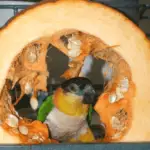
Parrot Quaker or monk parakeet ( myiopsitta monachus) is more commonly known as “Perruche Moine or Perruche Souris” in French. For my part, I prefer to use the English name of “Quaker” because it emphasizes its origin and the fact that it is far from possessing the docility of the parakeet.
Indeed, the word “Quaker”, which one could translate as “tremor”, originates from the behavior which is observable in babies of this species.
Quaker Parrot Baby

Quaker babies do nothing less than tremble with their whole tiny bodies when fed by their parents or a breeder. This juvenile behavior is very different from what can be observed in other parrots. Someone who is not used to being around this species might think that the bird is seriously ill.
I would first like to dedicate this article to Plume, an exceptional little Quaker with whom I have the chance to share my days and who never ceases to motivate me to try to understand her.
When talking to monk parakeet owners, you often get conflicting comments about this little bird.
Some are delighted with their little love on two legs, others simply cannot live with this tyrant anymore.
It makes you wonder if they are talking about the same animal. What makes this parrot the bird of paradoxes? Why do we have difficulty understanding this parrot? Why did Birds USA magazine give this bird the title of the most misunderstood parrot? Let’s try to demystify all of this.
Description
The Quaker is not known for its very colorful plumage. The same cannot be said for his personality! The majority of his body is light green, and he has a gray chest and head.
Its beak is horn-colored and its flight feathers are metallic blue. The different mutations in captivity generated birds of yellow color ( lutino ) and blue color; however, they are rare and much more expensive.
It measures an average of 29 cm and its healthy weight is between 150 and 220 grams. There is nothing humanly observable to identify whether it is a male or a female. Its longevity in captivity is around 30 years.
Quaker Parrot Colors
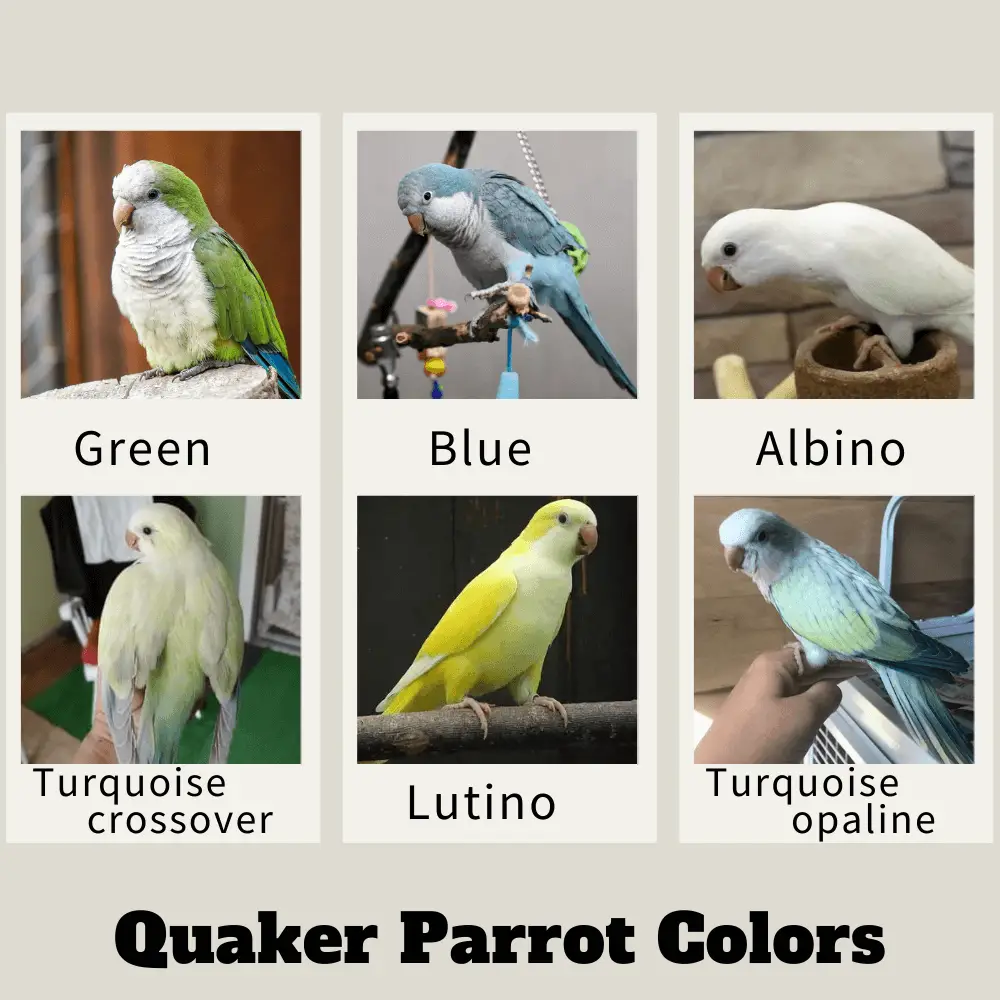
The typical colors of an adult Quaker are bright green on the head, wings, and back. The most distinctive feature of the bird is the gray chest, cheeks, and throat. This coloration resembles the clothing of colonial-era Quakers and is how this bird got its name.
It has gorgeous blue flight feathers and a lighter green tint on the underside of its tail. Their beak is horn-colored and their legs are gray. Overall, they look like a stocky cockatiel.
We also have a variety of beautiful monk parakeet color mutations. One of the most popular mutations is a blue hybrid Quaker parrot developed in the early 2000s. Breeders have also created Albino, Cinnamon, Lutino, and Pied Quakers.
This bird is a monomorphic species, which means that males and females look exactly alike. The only way to know for sure the sex of your bird is through DNA sexing or a surgical sexing procedure.
Quaker Parrot Behavior
An interesting fact about Quakers that says a lot about their distinctive behavior is that they are the only parrots that make their nests. The other species of parrots will prefer to nest in an already existing cavity by being satisfied with an arrangement on the spot.
Quaker Parrot Cage
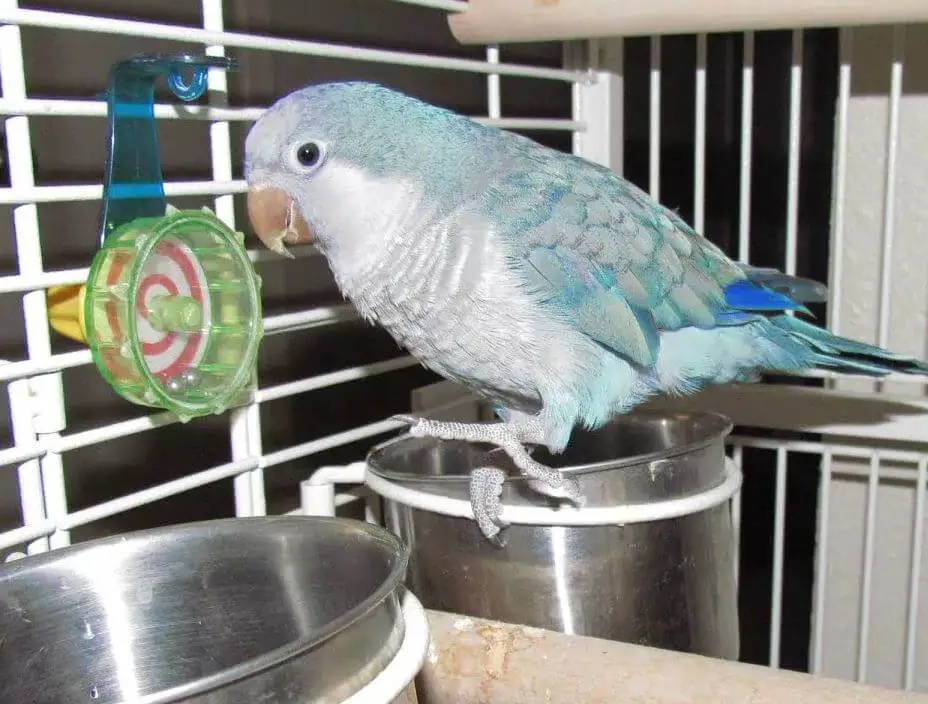
These birds will live comfortably in an ambient temperature of 60 to 80 degrees Fahrenheit. In the wild, they are able to adapt to harsh climatic conditions.
A monk parakeet cage should be a minimum size of 24x24x24 with a rung spacing of ⅝ to ¾ inch. But if you can afford a larger cage, you should go with the largest available. It will provide ample room for perches and toys to keep your bird flexible.
Also, try setting up perches of different sizes to keep its legs nimble. Installing the concrete blocks eliminates the need to clip nails. If the need arises, I advise you to consult a veterinarian first.
Quaker Parrot Nest
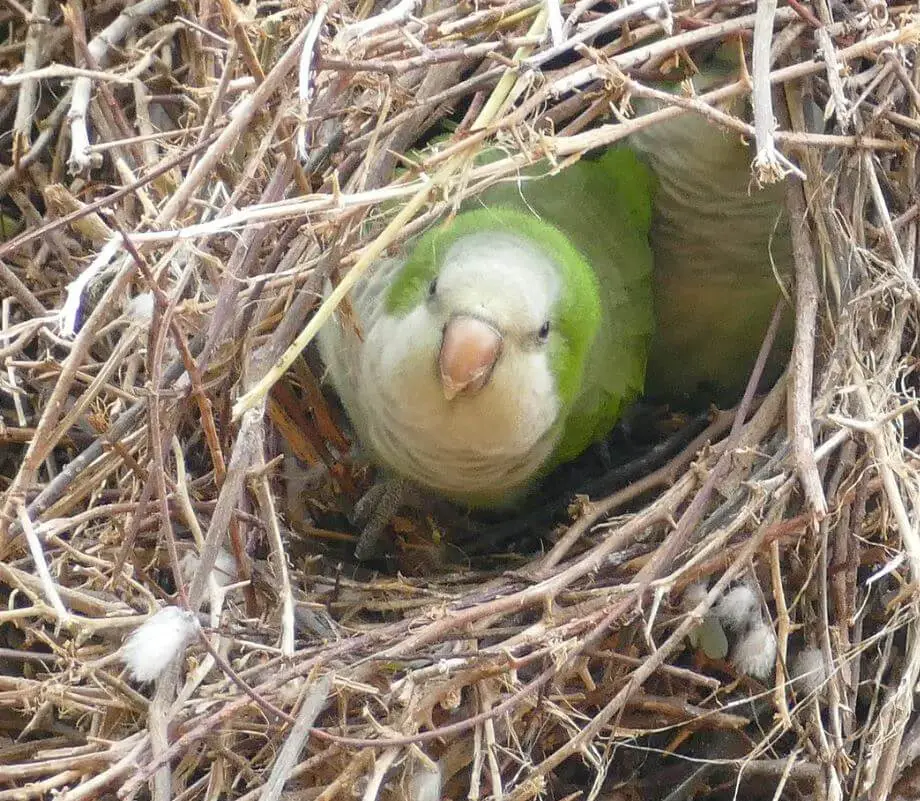
This nesting behavior, which is specific to the Quaker, makes it a much less “nibbler” parrot than other parrots. He will prefer to build ( in his own way ) rather than destroy.
This peculiarity also translates into an incredible need to control everything in its environment, which is, most of the time, its cage. I like to say that they do interior design!
The Quaker will set up his cage in his own way by replacing all the objects that are part of it, and if we try to put the small ladder back to where we think it should go, the next day it will be back to the place. where little monk parakeet wants her to be. What is the use of persisting!
Quaker Parrot Toys
Boredom is one of the most common problems with our winged companions found in captivity. We often have to be imaginative to find interesting activities to distract our parrot during our absences.
With the Quaker, boredom is easily avoided: all you have to do is get him coffee sticks, pencils, papers, ropes, pieces of cotton cloth, small “branches” ( well disinfected ), and he will be busy while we are away. to make its nest. The result will surprise you!
According to observations made in kind, a Quaker’s nest is usually made up of three rooms. A room that can be described as a bedroom, where the parents will hatch the eggs, another room that can be described as a living room,
where the chicks once weaned will be housed and another that can be described as a hall from where the parents will watch and protect the eggs and babies.
It is not for nothing that our charming little balls of green feathers act like a little tiger when we approach their territory, their cage! Females are generally more protective than males.
Quakers easily develop defensive behavior towards anything that approaches their territory. It is not uncommon to observe a Quaker who will literally rush to chase any intruder who enters his environment, the intruder can be a simple new toy or one of your guests.

The Quaker is often seen as a bird that is not afraid, but in reality, in order to defend its nest, it is willing to risk its life. This personality trait is extremely dangerous for his safety. It is not uncommon to see a Quaker trying to scare away the family dog, which can become fatal for him …
This is why, in a captive context, it is important to plan several areas of games so that the Quaker does not become too territorial towards his cage. the intruder could be a simple new toy or one of your guests.
The Quaker is often seen as a bird that is not afraid, but in reality, in order to defend its nest, it is willing to risk its life. This personality trait is extremely dangerous for his safety.
It is not uncommon to see a Quaker trying to scare away the family dog, which can become fatal for him … This is why, in a captive context, it is important to plan several areas of games so that the Quaker does not become too territorial towards his cage. the intruder could be a simple new toy or one of your guests.
The Quaker is often seen as a bird that is not afraid, but in reality, in order to defend its nest, it is willing to risk its life. This personality trait is extremely dangerous for his safety. It is not uncommon to see a Quaker trying to scare away the family dog, which can become fatal for him …
This is why, in a captive context, it is important to plan several areas of games so that the monk parakeet does not become too territorial towards his cage.
This personality trait is extremely dangerous for his safety. It is not uncommon to see a Quaker trying to scare away the family dog, which can become fatal for him …
This is why, in a captive context, it is important to plan several areas of games so that the Quaker does not become too territorial towards his cage.
This personality trait is extremely dangerous for his safety. It is not uncommon to see a Quaker trying to scare away the family dog, which can become fatal for him …
This is why, in a captive context, it is important to plan several areas of games so that the Quaker does not become too territorial towards his cage.
Quaker Parrot Breeding
Quakers are fairly easy to keep, and unlike many other parrots, they will build their nests. It is recommended to provide nest boxes instead to facilitate access to the chicks without destroying the structure.
Parents may desert their chicks if you disturb the structure of the nest they have built.
Their breeding season is between October and December. In one clutch you can expect around 4-12 eggs with a good chance they will all hatch within 24 days.
Quaker Parrot Diet
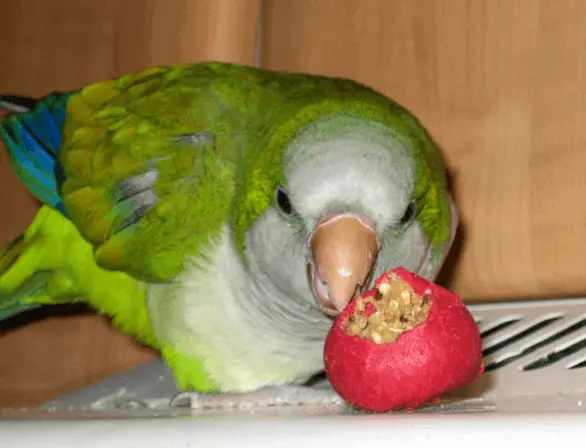
Quakers need a balanced diet that mimics their foods in nature to stay healthy. This includes seeds, fruits, vegetables, insects, nuts, and berries.
Oh, and they love chilies too!
It’s best to start with pellets for overall nutrition and mix with seeds later.
The thing is, seeds and pellets can cause fatty liver disease and sometimes cause your bird to gain weight. To avoid this, always supplement your Quaker’s diet with plenty of fresh vegetables.
Check out this list of nutritious and toxic foods for your monk parakeet.
Quaker Parrot in the wild
In the wild, Quakers live in large flocks ( over 100 ) and each pair will build their nests from that of the others, which ends up creating a very large “apartment block” of nests.
This peculiarity means that in captivity, the Quaker will easily accept other birds as long as each respects its territory. It has also been observed that the Quaker parrot will allow other species, such as bats, to share this building of nests.

Parrot Quaker Talking
Quakers are talkers and will learn words soon after arriving in a new home (a day or two if old enough). Although they may not be able to assemble an extensive vocabulary like the Green Quakers, they can still talk like crazy.
Best of all, many of their words are time-appropriate, which further proves their intelligence and ability to speak.
For example, Smooches, a green Quaker parrot would say “we go beddie bye” or “can we go to bed” if he is tired of perching and wants to go to his cage.
The good news is that parrot Quaker parrots are also able to speak this way, but with fewer words or phrases:
Quaker Parrot Sounds
A study conducted by Enrique H. Bucher, JL Navarro, and MB Martella on Quakers in their natural habitat has shown that they really communicate with each other.
The fact that several couples share the same “building” makes communication between them essential to identify and guard against predators. The study was able to identify eleven different types of vocalizations.
Each of these vocalizations generated a particular behavior in the other members of the group. It is therefore not surprising that the monk parakeet is very good at learning the human language and is also able to use it in the right context.
“Bird Talk” magazine ranked him among its top 10 best speakers in its June 1995 issue. However, this innate need to communicate with his social group also makes him very noisy, especially if he is in the presence of ‘other parrot Quakers.
Quaker Parrot Personality
The Little Quaker parrot is a very gregarious, interactive bird who constantly wants to be a part of the action. They are extremely intelligent animals who are constantly learning new things.
Therefore, it is also a bird that will easily become anxious if one is away for a long time. They are also reluctant to change and seem more difficult to adapt than other parrots.
The Quaker is a very sensitive bird that will easily develop stereotypies as well as anxiety behaviors such as pecking. It is important when living with a monk parakeet , to have time to devote to him and to teach him formulas of predictability to avoid our small ball of feather does not develop this kind of aberrant behavior.
Furthermore, it is a species of bird that has a fragile liver: a diet that is too fatty can also result in pecking behavior. Prevention is better than cure!
The Quaker is a very empathetic parrot that reacts to our moods and our verbal and non-verbal behaviors. For example, I remember a poker night with friends where Plume,
my little Quaker who was very comfortably positioned on my shoulder to be part of the group would laugh every time I got the slightest bit of a good game.
She was simply interpreting my body language before I could even raise the stake. There is no point in telling you that I got plucked!
The Quaker is known to always stand on the correct side of the perch. He is active, full of life, affectionate, comical and he exudes a joie de vivre that you cannot resist.
With all of the Quaker’s peculiar facial expressions, someone who takes the time to observe their bird will quickly find that it is very easy to understand what their little parrot is asking for.
A parrot, regardless of the species, should never be bought on a whim. The Quaker parrot, despite its affordable price and unassuming size, is not a parrot for everyone.
He has the personality and needs of a large parrot. Well socialized and in the presence of a human who will understand his difference and his special needs, he will be the perfect parrot, but in the hands of someone who does not have enough time for him and who does not manage to understand him. , it will be the worst tyrant.
Many Quakers are abandoned by their owners every year; one only has to go to the website of “The Grabiel Foundation” to see the great number of monk parakeets who are waiting to find a new family.
Quaker Parrots as Pets
Quaker Parrot Lifespan
The lifespan of parrots averages three decades. The closer their living conditions are to natural nature, the more comfortable the feathered pet will feel.
Do not forget that birds are prone to diseases such as gout and psittacosis, which can be cured only with timely treatment from a veterinarian.
A Quaker parrot has an average lifespan of 15 to 25 years. But with proper care, it can live up to 25 or even 30 years.
Parrot Quaker Price
Parrot Quaker costs an average of $400 depending on where you buy it. The main costs to consider are expenses related to maintenance, food, and occasional visits to the vet.
Conservation Status
Did you know that these adorable little feather balls are banned in just over 10 states in the United States? This is partly why they deserve the title of misunderstood parrot in the magazine “Birds USA”.
Indeed, several Quakers have been listed living freely in the wild on the American East Coast since 1964. Their particular nesting behavior has caused several damages to electrical installations and their territorial temperament having scared the local fauna,
the regulatory societies of American Wildlife have banned the possession and breeding of Quakers in those American states. The importation of Quakers has also been prohibited in the United States since 1993.
Unlike the Macaws, for whom the free-roaming population is declining due to habitat destruction, the Quakers moved and expanded to Argentina with the expansion of agricultural crops, with farms replacing their natural habitat. They are now feared like the plague by Argentinian farmers and are categorically driven out.
In Brazil, its country of origin, the monk parakeet is widespread in the wild, but it is also kept in captivity as a domestic animal.
Babies are often captured in the forest and sold for next to nothing in public markets. Because of its language skills, Brazilians felt the need to own one. There are even contests organized across the country to find who has the best speaker!
This is to say that it is not always profitable to be intelligent!
In light of these global situations, I consider it even more important to do everything in our power so that these little feathered dragons can live a long and happy life in our homes.
How To Train A Quaker Parrot | Pets | Great Home Ideas
SOURCE: Great Home Ideas

